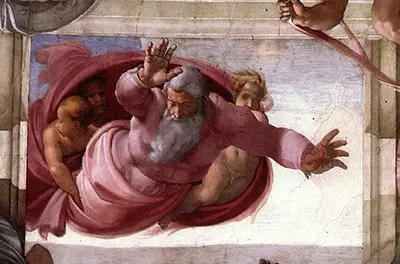What made Michelangelo stand out from the other painters in his time was the fact that he was keen on depicting this part of the Creation (of the world). According to him, the separation of the land from the water is fully in agreement with the Renaissance theology.
Mankind has always appreciated the splendor of the physical world and admired the entire wondrous process of creation.
The Separation of the Earth from the Waters painting is most probably the closest representation of the second day of creation even though God also created fishes as well as other marine and land creatures on that day. As mentioned in the Book of Genesis, Chapter 1, Verse 9 to 10, God had commanded that the waters under the heaven should come together in one place and dry land should surface.
The dry land was termed as ‘Earth’ by God and the water gathered together was called ‘Seas’.
A closer look at the painting reveals God taking a human form and moving towards mankind. Now, God has many forms, some of which are beyond the comprehension of human beings, but for this painting, Michelangelo decides to depict God as an old man with a long flowing beard.
Further, He is dressed in a swirling mantel which envelops His lower body and is accompanied by angels. This is something that is common in Michelangelo’s paintings, even the ‘Creation of Adam’ painting shows the same physical appearance of God.
As God is moving towards mankind, launching from the left side of the painting, His vast gesture seems to be reaching across the entire frame of the painting. He seems to be flying over a vast expanse of grey-blue calm waters.
The sky is bright and clear just behind the Creator, but on His other side the sky seems to have a greyish tinge to it. According to Giorgio Vasari, an Italian painter, historian, architect and writer, the figure of God seems to be continually changing direction and taking turns as one walks through the chapel and view it from different spots.
The Creator or God moving above the waters and His hallowing gesture indicates that he is blessing the world with his creations. This fresco in particular shows a stage just before the creation of man, as though God was creating a perfect world for mankind to inhabit.
If one were to look closely and count then one would notice that there are three angels peeking through from God’s cosmic cloak. This can be taken as a foreshadowing of the Holy Trinity. The study of this painting as well as the other frescoes of Michelangelo is a process that does something towards the individual’s own purification!
The paintings or frescoes in the Sistine Chapel is the perfect example of what a single person is capable of achieving with the right talent and skills. The works showcased here are indeed a beacon of art which illuminates the entire world.
Despite the criticisms and negative opinions about Michelangelo, it is indeed overwhelming to know that before him no painter has ever articulated or illustrated human pathos the way he did in these paintings.
In fact, some experts might argue that Michelangelo’s achievements in the field of art are just as important and massive as the invention of wheel or agriculture itself! It is no wonder people refer to him as one of the greatest artists (possibly) of all times! The everlasting beauty in his paintings is a spectacle for the eyes and a feast for the senses.


